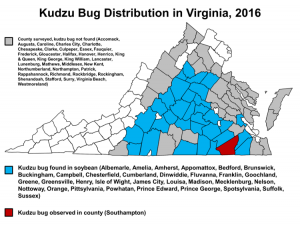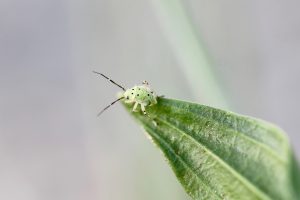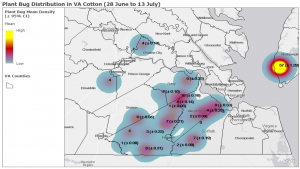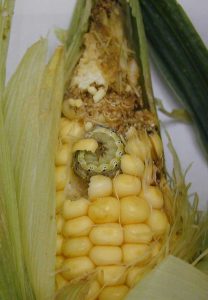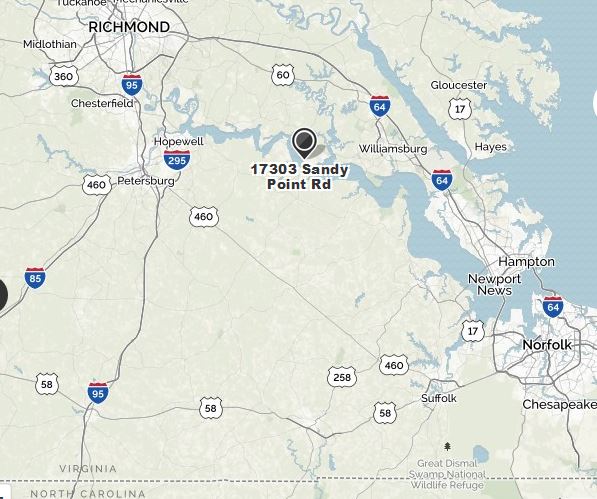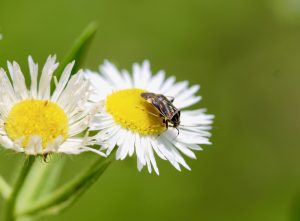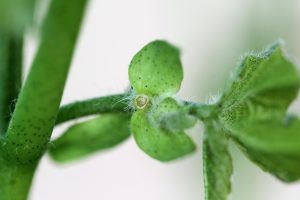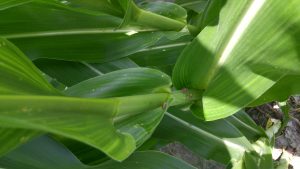This advisory is posted on behalf of Dr. David Langston. Both downy mildew and anthracnose of watermelons have been identified in the area recently. Please see the attached pdf for more details: Downy and anthracnose
Category Archives: Commodity
2017 Virginia Tech Small Grain Variety performance results
The 2017 Virginia Tech Small Grain Variety performance results have been posted.
A copy of the document is available at the following link:
http://www.grains.cses.vt.edu/Testing_results/Small_grains/2017/SG_17_2.pdf
Small upsurge in kudzu bug populations
Kudzu bug has been spotted above threshold (1 nymph per sweep – use at least 15 sweep samples in multiple parts of the field) in south central Virginia and in parts of central North Carolina. Kudzu bugs typically move into soybean in July-August in our state. Distribution surveys conducted by the entomology department in 2016 showed that kudzu bug are present in many soybean growing regions of our state.
Please consider the following information before making the decision to spray for this pest.
- Wait until nymphs (nymphs are wingless and cannot fly) are present in the field. Adults can make multiple invasions into a field. You do not want to make repeated sprays for this pest.
- Insecticides labeled for kudzu bug are broad-spectrum and will kill beneficials in your field. We are experiencing a large and early corn earworm flight this year in Virginia. Worm pests are much more likely to be a problem in fields that have been previously sprayed.
I’ll keep you posted on what we are seeing in soybean throughout Virginia. Please call if you have something to report.
Sally 919-801-5366
What You’ll See in the Field at the Virginia Ag Expo
 As another reminder, the Virginia Ag Expo is Thursday, Aug. 3 at Renwood Farms in Charles City. The event opens at 7:30 am and will run through mid-afternoon.
As another reminder, the Virginia Ag Expo is Thursday, Aug. 3 at Renwood Farms in Charles City. The event opens at 7:30 am and will run through mid-afternoon.
There is something for all corn and soybean farmers in the field this year. Go on the field tour and you will be able to chat with Extension Specialists, company reps, and others about the research being conducted or anything else on your mind.
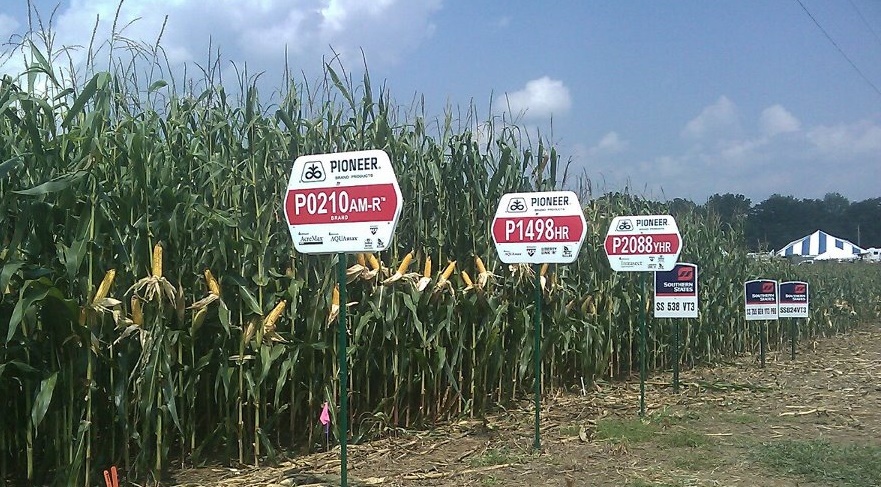 As always, the Ag Expo is home of one of our numerous on-farm corn hybrid and soybean variety tests. This year, you will view 31 corn hybrids from 11 companies and 47 soybean varieties from 14 companies. Drs. Mike Flessner and Charlies Cahoon will demonstrate off-site herbicide injury with some of our newest seed/chemical technologies. Dr. Wade Thomason is evaluating in-furrow and starter fertilizer in corn. The soil fertility team, led by Dr. Mark Reiter, is investigating fertilizer recommendations to ensure optimum production for high yielding soybeans. You will view one of Dr. David Holshouser’s seeding rate trials as he is in the process of establishing variable rate seeding recommendations. You will also see an experiment that you may have viewed at last year’s Ag Expo investigating the interaction of planting date with relative maturities. Companies are participating in our plots with in-furrow and foliar sprays that offer potential to enhance yield potential under high-yielding conditions. Finally, you’ll go below ground to view Virginia’s state soil, a Pamunkey loam, and discuss this yield contest-winning properties with NRCS personnel.
As always, the Ag Expo is home of one of our numerous on-farm corn hybrid and soybean variety tests. This year, you will view 31 corn hybrids from 11 companies and 47 soybean varieties from 14 companies. Drs. Mike Flessner and Charlies Cahoon will demonstrate off-site herbicide injury with some of our newest seed/chemical technologies. Dr. Wade Thomason is evaluating in-furrow and starter fertilizer in corn. The soil fertility team, led by Dr. Mark Reiter, is investigating fertilizer recommendations to ensure optimum production for high yielding soybeans. You will view one of Dr. David Holshouser’s seeding rate trials as he is in the process of establishing variable rate seeding recommendations. You will also see an experiment that you may have viewed at last year’s Ag Expo investigating the interaction of planting date with relative maturities. Companies are participating in our plots with in-furrow and foliar sprays that offer potential to enhance yield potential under high-yielding conditions. Finally, you’ll go below ground to view Virginia’s state soil, a Pamunkey loam, and discuss this yield contest-winning properties with NRCS personnel.
This is a walking, go-at-your-own-pace tour designed to fit your interest and schedule. Buses will be running continuously to take you to and from the plots. Enjoy!
Plant Bug Distribution Map
Twenty-three representative cotton fields in eight Virginia counties were scouted weekly for plant bug abundance and square retention. Data for the June 28th through July 13th sampling period is represented in the distribution map below (follow link to view). We will continue to post updates to the map through peak plant bug abundance in cotton. Sweep net and drop cloth samples were taken for each field to account for sampling bias associated with sweep net sampling towards adult captures and drop cloth sampling towards nymphal captures. When sampling cotton fields for plant bugs, look carefully for nymphs (pictured below). Since nymphs are flightless, they may spend more time feeding in an isolated area and cause more damage than adults because their movement in and out of fields is limited. The action threshold for plant bug in Mid-Atlantic cotton is generally eight plant bugs (i.e., adults and nymphs) per 100 sweeps in addition to square retention below 80 percent.
When viewing the distribution map in full-screen mode, click on the left arrow icon to view map legend. Click on sampling labels on the map to view square retention and number of samples taken from each site. Mean plant bug densities were calculated by sampling four sweet net samples (25 sweeps per sample) and four drop cloth samples across each field. Total adults and nymphs in a single visit were totaled and averaged for each visit within the sampling period.
Corn earworm and fall armyworm trap catch numbers in Virginia – Week of July 10, 2017
Corn earworm and fall armyworm are two important pests of a number of agricultural crops in Virginia. Sweet corn, in particular, is extremely vulnerable to attack by the larvae (or caterpillars) of these moth pests. Monitoring moth catch numbers in pheromone-baited traps can help IPM decision-making. See at the end of this post the Action threshold for spraying insecticides on sweet corn based on corn earworm trap catch. In general trap catch less than 1 per night means relatively low pest pressure and sprays can probably be spaced 5-6 days apart during silking. However, a catch of >1 or >13 moths per night means moderate and high pest pressure, respectively and a more frequent spray interval is justified.
In 2017, we are monitoring these pests on sweet corn farms in 11 different counties in Virginia. Moth Trap Catch Data are being recorded by: Katlyn Catron & John Few (Montgomery Co.); Jason Cooper (Rockingham Co.); Ursula Deitch (Northampton Co.); Helene Doughty (Virginia Beach); Kenner Love (Rappahannock Co.); Laura Maxey Nay (Hanover Co.); Steve Pottorff (Carrol Co.); Stephanie Romelczyk (Westmoreland Co.); Laura Siegle (Amelia Co.); Rebekah Slabach (Halifax Co.); and Mark Sutphin (Frederick Co.)
Here are the trap catch results (moths per night) for several locations around Virginia for this week (note we do not have data for all locations):
| Region | County | Field | CEW moths/night | FAW moths/night |
| Eastern Shore | Accomack | ESAREC | 1.1 | 0 |
| Eastern Shore | Virginia Beach | Pungo 1 | 1.6 | 0 |
| Eastern Shore | Virginia Beach | Pungo 2 | 3.9 | 0 |
| Eastern Shore | Northampton | Bridge Tunnel | 6.6 | 0 |
| Eastern Shore | Northampton | Capeville 1 | 3.6 | 0 |
| Eastern Shore | Northampton | Capeville 2 | 0.0 | 0 |
| Eastern Shore | Northampton | Eastville | 0.6 | 0 |
| Eastern Shore | Northampton | Nassawaddox | 1.0 | 0 |
| Piedmont | Amelia | Field 1 | 2.7 | 0 |
| Piedmont | Hanover | Field 1 | 2.1 | 0 |
| Piedmont | Hanover | Field 2 | 1.0 | 0 |
| Northern Neck | Westmoreland | Field 1 | 3.0 | 0 |
| Shenandoah Valley | Rappahannock | Field 1 | 1.0 | 0 |
| Shenandoah Valley | Frederick | Field 1 | 2.3 | 0 |
| Shenandoah Valley | Frederick | Field 2 | 3.5 | 0 |
| New River Valley | Montgomery | Whitethorne | 1.9 | 0 |
| New River Valley | Montgomery | Wall field corn | 1.1 | 0 |
| New River Valley | Montgomery | Wall sweet corn | 20.8 | 0 |
| Action threshold: Number of Corn Earworm Moths Caught in Pheromone trap | |||
| Per Day | Per 5 Days | Per Week | Spray Interval for sweet corn |
| <0.2 | <1 | <1.4 | No Spray |
| 0.2 – 0.5 | 1.0 – 2.5 | 1.4 – 3.5 | 6 Day |
| 0.5 – 1.0 | 2.5 – 5.0 | 3.5 – 7.0 | 5 Day |
| 1.0 – 13.0 | 5.0 – 65.0 | 7.0 – 91.0 | 4 Day |
| >13.0 | >65.0 | >91.0 | 3 Day |

2017 Virginia Ag Expo Returns to Charles City County
Please note: the date for the Virginia Ag Expo is August 3, 2017.
“Focused on Productivity, Management and Stewardship” is the theme for the 2017 Virginia Ag Expo. The Virginia Ag Expo, hosted by the Virginia Grain Producers Association and the Virginia Soybean Association in partnership with Virginia Cooperative Extension, is the largest agricultural field day held in the Commonwealth of Virginia. As an educational, marketing and social event farmers and agribusiness look forward to the Virginia Ag Expo each year.
Renwood Farms, owned and operated by The Stanley Hula Family, will be hosting this year’s Ag Expo on August 3. The Hula Family’s farm is a diversified operation growing over 6,000 acres of corn, soybeans and small grains; along with seed conditioning and sales. A focus on management and productivity at Renwood Farms has produced the world record corn yield of 532 bushels per acre by David Hula. In addition, the USG soybean seed that produced the world record yield of 172 bushels per acre was grown and conditioned at Renwood Farms.
Over 150 exhibitors and sponsors will have on display all of the most up to date equipment, goods and services for agricultural producers and property owners no matter how large or small.
The event opens at 7:30 am. The field tour, starting at 8 am, is a walking, go-at-your-own-pace tour designed to fit your interest and schedule. Buses will be running continuously to take you to and from the plots.
Breakfast and lunch will be provided by Virginia food vendors. Attendees will be able to eat any time from 6:30 AM to 2:00 PM.
Renwood Farms is located at 17303 Sandy Point Road, Charles City, VA 23030.
Tarnished Plant Bug Update
My name is Seth Dorman, and I’m a graduate student with Dr. Sally Taylor in the Virginia Tech Department of Entomology. My research focuses on tarnished plant bug (Lygus lineolaris) management and distribution in Virginia cotton. In recent weeks, large numbers of tarnished plant bug have been active throughout southeastern Virginia in fallow fields and ditch banks with an abundance of flowering, weedy hosts as well as in corn. Plant bugs have begun migrating into some early-planted cotton fields and were observed in cotton fields in Suffolk and Southampton counties last week.
Tarnished plant bug may move from preferred alternative hosts into cotton fields as flowering weeds senesce, and cotton plants begin to develop small, pinhead squares and subsequent flowers. Feeding during early squaring can cause plants to abort squares. Feeding on larger squares and small bolls may cause anthers in flowers to turn brown (“dirty bloom”), and small bolls to shed. Sustained feeding by tarnished plant bug from first square to early bloom can delay maturity and result in substantial losses. Scouting cotton fields once or twice a week is highly recommended after squares become visible on plants. The best indirect method for sampling plant bug is estimating square retention. Square retention can be measured by calculating the percentage of squares in the top two or three nodes of 25 randomly selected plants in a given field. If square retention drops below 80%, direct sampling for plant bugs with a sweep net is recommended. For sweep net sampling, conduct a minimum of eight 25-sweep samples randomly throughout your cotton field. We recommend using Admire Pro or other neonicotinoid products until bloom. Adult plant bugs can reinfest quickly following applications. Use restraint when treating early in the season when plants have time to compensate for injury.
More updates on plant bug activity throughout Virginia’s cotton regions will be posted soon!

Soybean Planting Dates, Seeding Rates, Re-planting, Weeds, etc.
June is usually the time of the year when full season soybean is kicking into high gear and we begin planting double-crop soybean. And like always, various issues are beginning to arise, whether its the weather or finding out mistakes made a few weeks earlier.
Unbelievably, double-crop soybean is wrapping up in many areas due to small grain maturing earlier than normal. Out of necessity, we were forced to harvest wheat and plant soybean at the same time we were trying to make timely postemergence herbicide applications and generally trying to pay attention to the rapidly growing soybean that we planted in April and May. But, issues such as these are not unusual.
This week, I thought I’d mention a few things that we are facing and continue to remind you of the need to plant as soon as possible and adjust seeding rates accordingly.
Planting Date. We are now losing about 1/2 bushel per acre per day with each delay in soybean planting. Plant as soon as possible, but don’t cause more serious problems by planting into too wet or dry soils.
Seeding Rate. My data indicates that seeding rates now need to be at least 180,000 seed per acre, even on the best of soils. I would bump those up about 20,000 seed for each week’s delay in planting. See Soybean Seeding Rates for June and Later for more information.
Replanting. Generally, replanting does not pay this time of the year (due to the planting date penalty) unless the stand is horrible. For more information, see Soybean Replant Decisions or contact me.
Seed Treatments. I’ve seen few benefits of fungicide or insecticide seed treatments this time of year. Plants usually emerge and grow quickly. The exception is wet soils – soybean will emerge very slow when soils are saturated. With that in mind, you may consider a fungicide on the seed if you have poorly-drained soils, your soils are already wet, and rain is predicted.
Seeding Depth. Those of you know that I usually don’t like to plant soybean greater than 1 inch. But, I’ve found that planting soybean at 1.5 inch (and occasionally 2 inches) works just fine when soils are warm. Sometimes, it’s better to plant deeper to hit moisture than to plant into dry soils.
Weeds. First, Drs. Charlie Cahoon and Mike Flessner is who you need to consult regarding weeds, but here are a few of my observations. We may have let a few weeds get too big for adequate control – this is especially a problem with glyphosate-resistant weeds. Marestail continues to be a problem. When this weed is glyphosate resistant and you’re not growing Liberty-Link soybean, about the only somewhat effective herbicide that we have left in our arsenal for Roundup Ready soybean is FirstRate, although a few other herbicides may burn the weed – just don’t expect very much from anything. I’ll let you mull over your other options if you have planted Xtend soybean. Finally, don’t depend on glyphosate alone – even if you weeds are not yet resistant, its a good practice to diversify to insure that they do not become so.
Stink bug numbers continue to climb
Brown stink bug numbers have continued to increase in eastern Virginia from the Northern Neck to the Tidewater region. We have scouted fields in Suffolk and Caroline County with higher than threshold infestations spanning the entire field. Infestations in most fields remain confined to border rows and the majority of infested fields are near where wheat has been recently harvested.
Many growers are facing the decision to treat. Previously I had reported a threshold of 1 bug per 4 plants. In order to be extra protective during ear formation and elongation, treatment at the 1 bug per 10 plants threshold can be justified for heavily infested fields. More information about stink bugs in corn can be found here – NCSU corn stink bug management considerations.
The ability of stink bugs to injure corn depends heavily on corn growth stage. Trials at the Tidewater Research Station have shown that stink bug feeding does not always reach developing ears. The photo below shows a healthy ear developing (VT growth stage) despite multiple feeding lesions to the outside of the stalk. This may be good news for Virginia growers. We cannot determine if yield was effected in these plants until later this season.
This week, we will be rechecking fields that were treated with aerial applications and post updates on the effectiveness of these sprays.

